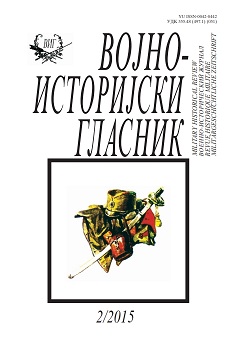Реформа српске војске у време Стефана Душана
Serbian Army Reform During the Period of Stefan Dušan
Author(s): Marko AleksićSubject(s): Governance, Military history, Political history, Military policy, 13th to 14th Centuries
Published by: Institut za strategijska istraživanja
Keywords: Serbian medieval army; Stefan Uros VI Dusan; heavy cavalry; armor; chivalry; XIV century; mercenaries;
Summary/Abstract: One of the main stages in the development of the medieval Serbian Army was the reform carried out by King and Emperor Stefan Dušan Nemanjić (1331-1355). During his reign, a unit of 300 heavily-armed mercenaries was present in the country as the ruler's bodyguard. Preserved in the Dubrovnik archives is a document containing an equipment list of one of the members of this unit. The individual soldier’s equipment consisted of two torso coat plates of armor (coracia), three barbute helmets with mail collar (barbutas cum mallis), three great helmets with a crest, two mail collars, a pair of metal armor for the legs to the knees (greaves), a pair of metal cuisses, a pair of metal gloves, two tunics (surcotte), a blanket for horses, and three saddles. In the absence of documents on local arms production, significant data provide information from the Venetian archives. They show that in the period from 1341 to 1349, there were five major imported military equipment shipments Serbia received, consisting of 1,700 coat of plates (coracias), 800 barbutas, 500 sets of chain shirt with a covering for the head and neck, 800 mail collars, 1000 pairs of greaves, 600 pairs of metal gloves, 700 shields of which 400 were “in the Slavic manner,” 100 sets of weapons for horsemen, and many other undefined items of armament. Imports into medieval Serbia were also from other trade routes, so these large numbers of arms and armor, which probably came from northern Italian workshops, should not be considered to be final. Venetian archival data on the types of weapons shows that Dušan was importing the same type of equipment which was used by mercenaries in his service. Its numbers, which coincided with orders of between 300 and 500 pieces, show that he was establishing new domestic units of heavily-armored cavalry. Historical data about 500-man detachments under the command of the Duke Prelub in 1344 and 1350, as well as a detachment of about 300 menat- arms under the command Djuraš Ilijić from 1355, identify some of the local military units that Dušan founded and for which the imported equipment was intended. Heavy cavalry was one of the most important combat units of medieval armies, which set the model for tactics of other units and of the army as a whole. Therefore, the establishment of new heavily-armored cavalry units and their introduction into the battle line of the army led to significant innovations in its structure and military tactics. The use of heavy cavalry in the Serbian Army can be reliably dated to the Battle of Velbužd in 1330 where Stefan Dušan was personally leading the attack of these units, which were composed mostly of mercenaries from the West. Dušan Nemanjić is remembered as a fancier of chivalrous traditions and organized knight tournaments whose winners were rewarded with a knightly belt. At that time the custom of possessing a family coat of arms had spread among the Serbian nobility which, along with other information, suggests a booming of the chivalric culture in Dušan`s Serbia. The practice and ethos of chivalry, which was not just a collection of popular cultural patterns of medieval society, but primarily an important element for raising the fighting morale of the whole army, spread throughout medieval Serbia. It is another element, in addition to the modernization of arms and armor, that contributed to the establishment of new military units of heavy cavalry, as well as tactical modernization of the whole army, of Stefan Dušan’s reform of the Serbian Army.
Journal: Vojnoistorijski glasnik
- Issue Year: 2015
- Issue No: 2
- Page Range: 9-32
- Page Count: 24
- Language: Serbian

